Written by Joel T. Lewis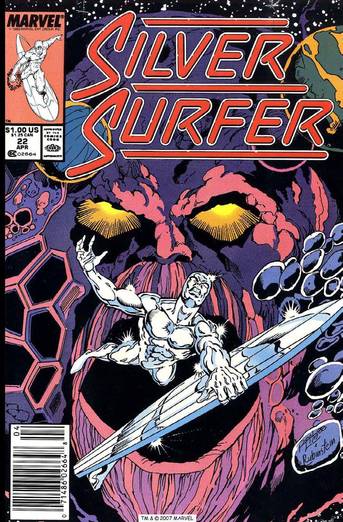 After his first dramatic clash with the Fantastic Four in 1966, Silver Surfer’s first series focused on the plight of a cosmic being trapped on earth. Plagued to remain among a violent humanity prone to misunderstanding, the Surfer desired to break the bonds of his exile and return to his home world Zenn-La and his love Shalla-Bal. The first series of Silver Surfer attempted to ground the character by shackling him to earth and pitting him against familiar heroes like Spiderman and the Mighty Thor and earth-bound villains like the Abomination and Mephisto. I began reading Silver Surfer for the very first time a little over a year ago and though I loved the character and those first 18 issues, I was slightly disappointed that the Sentinel of the Spaceways had been grounded. Norrin Radd wasn’t surfing among the stars as I knew he did in later series and his string of interactions with the people of earth were frustrating and a bit repetitive. The second Silver Surfer series of 1987 finally allowed the hero to break away from Earth and return to the space lanes and I really enjoyed seeing Norrin Radd in his element. One of the most interesting issues I’ve read from the 1987 series of Silver Surfer depicts a man-on-planet conflict between a board-less Silver Surfer and Ego the Living Planet. Any complaints I had about an earthbound Silver Surfer from the first series were quickly silenced by issue 22. The cosmic scale of pitting Norrin against an Elder of the Universe was instantly satisfying. From the first splash page revealing artist Ron Lim’s massive rendition of Ego to the final panel of the Surfer zooming away to stars unknown, issue 22 captures everything I love about this series. Ego, who has to devote the majority of his might to combating the propulsion unit that Galactus attached to him in a previous adventure, has now become a devourer of worlds in his own right and plans to make the Surfer his next meal. Learning from the mistakes of the other Elders of the Universe, Ego separates Silver Surfer from his board and writer Steve Englehart sends the Sentinel of the Spaceways on an exploration of the planet-being’s anatomy. With magma coursing through his veins and crude oil pumping through his lymph system, Ego fights Silver Surfer the way a body would fight off infection. Using Protozoids in the shape of bizarre tiger sharks, Ego tests the limits of the board-less Surfer’s power and resolve. Ron Lim’s artwork really shines as Silver Surfer wields the power cosmic through magma and stone, demonstrating how massive Ego is while showcasing the wide range of the surfer’s powers. There's something about a single issue from the 1980’s that's really special. Maybe it's the quality of the colors, or the feel and smell of the ink on your fingertips as you flip the pages, but reading those comics will always feel special to me. You can feel the age of the comic in your hand in a way you can’t with the glossy modern issues that hit the shelves now. If you’ve never read a Silver Surfer comic before, his massive back-catalog of issues can be a bit daunting. With a character whose first appearance (Fantastic Four #48) can fetch thousands of dollars, it can be a little intimidating trying to start from the beginning. But thanks to a Marvel Unlimited subscription and the Marvel Essential TPB series, I was able to fill in the early history of the character without shelling out a lot of money. Silver Surfer can also be difficult to approach because of the alien stoicism that has been written into his character in recent years, but the Norrin Radd of the 1987 series is a lot of fun. As the Surfer hurtles through space there are great one-off issues that you can jump into without a whole lot of context, which is nice considering there are 146 issues in the second series. Strange colorful creatures, cosmic forces, and amazing exclamations like, “Nebulae Unfolding!” are just a few of the elements you can expect when you pick up a Silver Surfer comic, and issue 22 is a great showcase of how unique and profound Norrin Radd is. Until next time, Geek On!
0 Comments
Written by Joel T. Lewis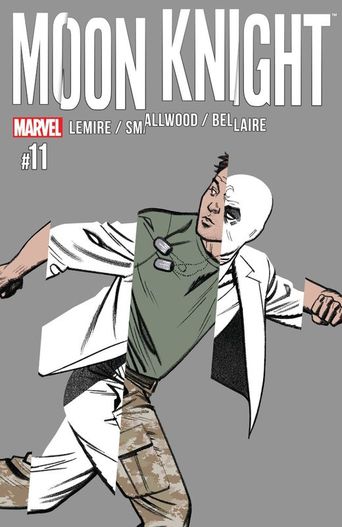 In the past 10 issues of Moon Knight there has been a considerable amount of uncertainty. As we have followed Marc Spector’s shifting realities and corresponding identities we have not been able to make any definitive claims about the actual history of Jeff Lemire’s incarnation of the character. There have been subtle references to possible pasts but much of the Moon Knight mythos has been wreathed in shadow as Lemire showcased the internal struggle of Marc Spector. But this current “Death and Birth” arc has begun to make definitive assertions about the history of Moon Knight through flashbacks. Last issue, Lemire showed that Spector developed his Dissociative Identity Disorder when he was a child and Khonshu’s manipulative influence began at the same time. Issue 11 follows Moon Knight’s journey into the Othervoid but also shows us more of Marc Spector’s past. I won’t disrespect Greg Smallwood’s wonderful artwork in this issue by telling you all that transpires as Mr. Knight navigates the Othervoid, is captured, and then taken to be sacrificed. Suffice it to say that I was reminded of the 1982 Arcade game Joust (and that is in no way a criticism). Mr. Knight discovers that he’s been sent back to rescue Anubis’ wife, Anput, who has been imprisoned by the same forces that call for his own sacrifice. Swallwood’s panels do not disappoint as Mr. Knight trades blows with soldiers who appear to be from ancient Egypt. Though I am very interested in Moon Knight’s looming final showdown with Khonshu, I have been more fascinated with how Lemire is filling in the Marc Spector origin story. There is no father-son boxing match in this issue but we do get to see Spector attend his father’s funeral and we meet Mrs. Spector for the first time. Approved for a week away from Putnam Psychiatric Hospital so that he may attend his father’s funeral, young Marc Spector argues with his Mom over whether or not his father would have wanted him to attend. Marc’s belief that his father was ashamed of his son and was happy to send him away shows the resentment Marc has been cultivating since he’s been away. His mother assures him that his father only wanted him to get better, but when Marc begins to transition into Jake Lockley to help him cope with the passing of his father she responds with frustrated anger. You can easily read the tension and resentment in the Spector household in so few pages and you don’t blame Marc when you see him run away. We then fast-forward to Marc’s deployment to Iraq and discover that he’s been sleepwalking. Into minefields. Spector hears the ominous call of Khonshu across the desert sands and isn’t able to resist its pull. Private Spector’s history of strange behavior throughout his two tours in Iraq prompts his commanding officer to investigate his past. He discovers that Private Spector lied on his recruitment forms about his history of mental health problems which leads to his dishonorable discharge from the Marine Corps. Following the voice of Khonshu and afraid of returning to the states and to Putnam Hospital, Marc runs away again. When we fast-forward again, we find Marc in the middle of an unlicensed boxing match, beating the hell out of another man. After the fight Marc talks with a man who’s admired his skill from afar and has noticed his tendency to shift from persona to persona. The man asks if Spector would like to go into business together and when he agrees we discover the man to be Jean-Paul “Frenchie” DuChamp, Moon Knight’s dear friend and pilot. 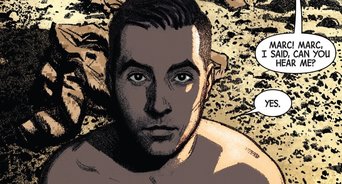 Once again Jeff Lemire has artfully filled in a blank section of Marc Spector’s origin story. Before this issue, Spector’s military service was only ever mentioned in passing and never with any detailed specifics. It was never clear which war he had seen action in, what rank he attained, or what circumstances led to his departure. Now Lemire has answered all those questions and given us a better understanding of how Khonshu influenced the crucial events in Marc’s life. This issue also demonstrates the first tactic Marc employs to cope with his Dissociative Identity Disorder: running away. Smallwood’s panels showing Marc fleeing from his father’s funeral and from the military base in Iraq echo one another and show a scared, frustrated young man who doesn't fit in where he thought he did. He's told by his commanding officer that the Marine Corps has no place for a man like him and his mother makes him feel unwelcome in his own home. All Marc can do is run. Until he meets Frenchie. In Lemire’s Moon Knight origin story Frenchie is the only person to have a favorable reaction to Marc’s shifting identities. Frenchie sees a powerful fighter with demons like everybody else but when he refers to Marc’s different personalities he almost shrugs it off. For the first time, someone responds to Marc’s condition with something besides fear and misunderstanding and it has a huge impact. We never really got to see what solidified Marc and Frenchie’s friendship in previous comics but this very brief meeting in issue 11 shows that from the very beginning Frenchie treated Marc like a human being. I imagine that this kindness in Frenchie is why they remained such firm friends over the years. The next issue of Moon Knight will pick up with the beginning of Marc Spector’s mercenary career and perhaps we'll catch a glimpse of his oldest and most ruthless enemy, Raoul Bushman. Until next time, Geek On! Written by Joel T. Lewis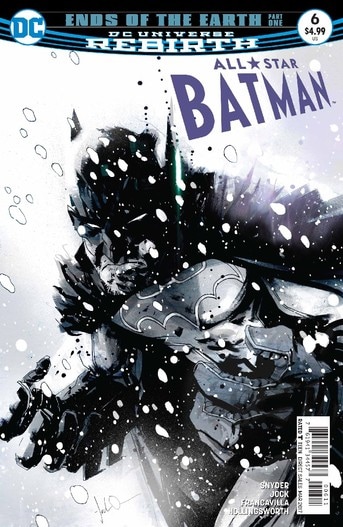 Issue 6 of Scott Snyder’s All-Star Batman shifts gears quite dramatically from the conclusion of the Two-Face storyline. With a new artist, a new villain, and a new setting, issue 6 feels like a brand new comic and is a great entry point into All-Star Batman if you missed the previous 5 issues (though it would be a shame to skip that storyline!). It’s also a great self-contained story that can be read in isolation if you just want to dip your toe into the series. Batman has tracked Dr. Victor Fries to an abandoned research outpost in the Alaskan wasteland. Throughout this series Scott Snyder has made a habit of taking Batman away from Gotham which allows him to showcase the hero’s resourcefulness and adaptability without relying on Alfred or his Batcave headquarters. This issue’s setting also allows Snyder to depict Mr. Freeze in a way we’ve never seen before: exposed. Mr. Freeze is a character defined by the fact that he is perpetually out of his element. He is literally separated from society by his environmental suit and whenever he is out of that suit he’s always restricted to cramped, uncomfortable settings. Whether it’s a refrigerated cell in Arkham Asylum or a Climate controlled lair Freeze is cut-off, isolated, and separate from humanity. But in this issue Freeze is out and about, finally at home in a climate that suits him and its Batman who’s sporting a high-tech climate suit. Snyder gives us an intimate look into Mr. Freeze’s dreams of a world where he might roam free, breathe air designed for him, and where he might father a whole generation of frozen silence. Batman experiences the isolation and immobility that Freeze has become accustomed to over the years in a suit meant to insulate him from exposure to the extreme cold. This inversion of isolation and insulation showcases how formidable Victor Fries really is even without his suit. Freeze plans to eradicate humanity with an ancient virus held within one of the earth’s oldest ice cores. Once humanity is gone, Freeze plans to replace it with a legion of reanimated cryogenic zombies. Yes, you read that correctly. Cryogenic Zombies. Now this is far from the first time we’ve seen the caped crusader trade blows with the undead, but I think it’s pretty safe to say that Batman has never dealt with this particular flavor of zombie before. These pale red-eyed creatures challenge even Game of Thrones’ White Walkers on the heebie-jeebie meter thanks to the chilling illustrations from artist Jock. The combination of Jock’s visceral outlines and Mike Hollingsworth’s use of light and color makes for a stunning comic that is both terrifying and beautiful. The stark contrast between the snowy landscape and the cavernous darkness of the ice caves is really breathtaking and you can almost feel the chill coming off the pages. Now, following this series throughout last year, I was impressed with the high gloss presentation and quality of each issue. This higher quality presentation along with the mini-comics at the end of every issue justified the higher price point of $4.99 per issue that I mentioned in my second article on All-Star Batman. However, this issue suffered a bit from poor quality control on the part of DC comics. As this issue came after the first of the year, a lot of space was taken up by promotional ads for upcoming publications, which is perfectly acceptable and understandable but, some of these ads interfered with the issue’s artwork by bleeding through from the other side of the page. Now, ads are something that have accompanied comics for decades, and for the most part they manage not to distract you from the narrative, but it’s disappointing to see artwork as outstanding as Jock’s interrupted by advertisements. Despite this tiny frustration, All-Star Batman No. 6 is a great one-off Mr. Freeze story that shows how far Batman will go to save humanity. This issue kicks off a story arc that will feature one big villain with each new issue, and the next installment will star Poison Ivy. Until next time, Geek On! Written by Joel T. Lewis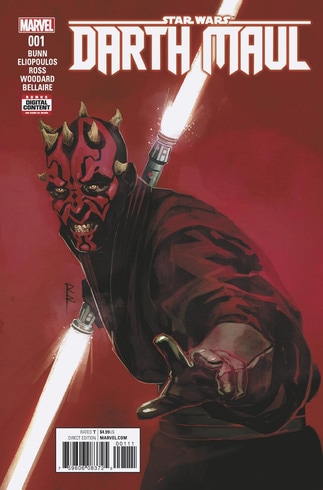 As long as I've been alive, there's never been a better time to be a Star Wars fan. With two reasonably well received films in the last two years, the Rebels TV show, and a wash of new novels and canon comics the Star Wars franchise is alive and well. Not that it ever really went away, as countless games, novels, and comics throughout the years can attest. But, it has been an uneasy time in terms of taking in new content, at least for me. As a child I spent many a night huddled under my covers with a flashlight desperate to finish one more page, one more chapter of the dozens of Star Wars Expanded Universe (EU) novels I collected from countless birthday lists and my local library. I read them at recess at school, despite the jeers of the other kids. I made lightsaber crackles and thrums with my mouth as I dreamed of fighting at the side of Luke Skywalker or swooping in from above in a T.I.E. Interceptor going full throttle. I lived in the Star Wars Universe thanks to those novels. Now when George Lucas sold the rights of the franchise to Disney they assembled a committee to determine the future the universe I had treasured for so long. The result of that meeting was that the stories I grew up reading were to pass into legend and going forward all new content would be considered true canon. Now I'll be the first to admit that the worst thing about Star Wars fans is our inability to accept what we deem to be inappropriate or unnecessary changes to our favorite universe. Take midichlorians, or the prequels, or Anakin’s sand speech in Attack of the Clones for example. We love to take apart and complain about what Lucas or whoever did to our Star Wars. I realize it's not as if Disney came into my library and burned my copies of the Thrawn Trilogy or the Rogue Squadron series but learning that stories that were such a big part of my childhood, of my budding imagination as a kid, weren't part of the Star Wars story anymore cut me deep. As a result, I have been timid with respect to the flurry of new canon material that has come out since Disney acquired Star Wars. I didn't really want to invest myself in new stories that would gloss over the ones I had grown to love or devour a new canon when the old was snatched away so easily. That's not to say I haven't been curious. I’ve looked over the new novels, and watched a bit of Rebels, but I was really interested in re-entering the Star Wars universe through comics. I had heard that Marvel’s newest Star Wars comics were exceptional but was unsure whether I should catch up on the main title or follow Solo, Princess Leia, or Poe Dameron. Then I heard that Darth Maul was getting a new comic and less than a week later I bought and devoured the issue I'm about to discuss. 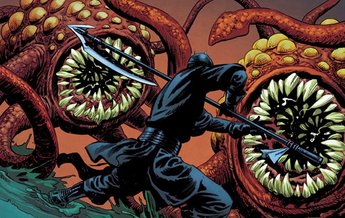 Maul was always characterized in the old EU as a man composed of frustrated anticipation. He was trained to be a weapon, hell it’s even in his name, Maul, but much of his time was taken up with cloak and dagger missions where his main objective was to avoid direct conflict with the Jedi. In his frustration and fundamental belief that his talent was being wasted, Maul constantly set himself against every dangerous opponent he could find to test his skills as a fighter. This desperate search for a worthy opponent, for a true test of his skills was ever at the center of Darth Maul’s motivations. This spirit has carried over into this first installment of Darth Maul comics. In many ways this issue serves as a Darth Maul refresher course, reestablishing the tried and true character building that the old canon contributed to Maul’s legacy. It may seem a bit repetitive to veteran Star Wars fans but it is a great introduction to everything that made Maul such a compelling villain: his overwhelming desire to prove himself worthy of the Sith mission, the tenuous power dynamic between Maul and Darth Sidious, and most of all Darth Maul’s viciousness. At the beginning of the issue we find Maul in the middle of a recreational hunt in the jungles of the planet Twon Keetee. What's the dark lord of the Sith hunting you might ask? Rathtars. In just two pages, author Cullen Bunn establishes a through-line of continuity with The Force Awakens and sets one of the most formidable characters of the prequel era against one of the more vicious elements of the post-Empire period. But what's most impressive about the battle between these two forces of nature is that Maul engages the Rathtars with a pole axe and not his signature double-bladed lightsaber. This showcases the skill and fury of Maul’s fighting style but also enhances our anticipation to see his weapon of choice later in the issue. Maul returns to Coruscant and is scolded by his master for nearly being discovered by two Jedi prior to their meeting. Sidious warns Maul about not allowing his impatience to sabotage their grand scheme to overthrow the Jedi and dispatches him to rescue members of the Trade Federation from pirates. After a dogfight above the surface of the planet involving Maul’s starship the Scimitar (which is one of my favorites), Maul discovers that a crime boss has taken a Jedi Padawan and is holding them for ransom. Taking it upon himself to get to the Padawan before the Jedi, Maul slaughters all witnesses to keep his mission a secret from his master. Though this issue is basically a primer for what's to come, it's great to see Darth Maul come to life again before his first duel with Obi-Wan Kenobi and the obsession fueled episodes of the Clone Wars series that followed. If you think that a series centered on such an intense, vengeful character might be a little too dark to read month after month there is a surprise mini-comic at the end of issue 1 that was a great palate cleanser and really sold me on picking up the next issue. Until next time, Geek On! Written by Joel T. Lewis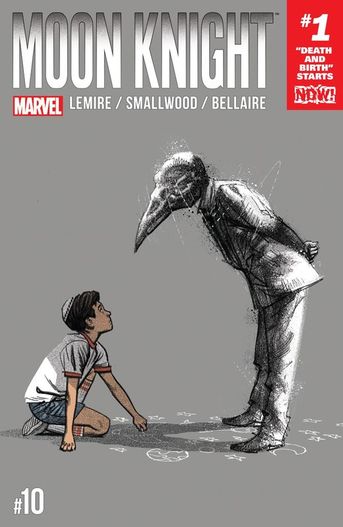 If it is not apparent by now I’m going to state it for the record officially: I adore Jeff Lemire. Thanks to this most recent series of Moon Knight I’ve been exposed to one of the most innovative and powerful storytellers of our time. I was wholeheartedly in his corner from the first issue of this series but with issue 9, Lemire cemented himself into my soul. Issue 9’s impact on me has been so profound that I’m still a bit raw emotionally from having written about it so recently. From the ending of issue 9 I wasn’t sure what to expect next from this series. Without the three conflicting identities that were so heavily featured in the previous 9 issues I wondered whether Lemire would follow a more conventional linear storyline or surprise me yet again. Lemire managed to do both. Issue 10 follows Marc Spector as he journeys back towards Mercy Hospital, determined to kill Khonshu but also gives us an intimate look at Marc’s childhood via flashbacks. Through these flashbacks Lemire reveals the origin of Spector’s Dissociative Identity Disorder but he also introduces a character from the Moon Knight mythos who we haven’t seen much of in recent years: Rabbi Elias Spector. The father of Moon Knight. Oh yeah, did I neglect to mention that the resurrected avenger of an Egyptian Moon God is the son of a Rabbi from Chicago? While Marc Spector has never met up with Ben Grimm at the Synagogue for Shabbat, his Jewish heritage is another aspect of Moon Knight that I thought was really unique when I first starting reading his comics. Though there are very few references to Spector’s Jewish heritage in the comics, it is one of the contributing factors to his estrangement from his father. While there have been several storylines that focus on Marc’s tumultuous relationship with his younger brother Randall Spector (which I hope to discuss soon as Lemire seems to be moving in that direction) much of Marc’s history before his mercenary days is left open to speculation. But at the tail end of the first Moon Knight series (1980) writer Alan Zelenetz shed some light on Marc’s rebellion against his religious father. As the first series of Moon Knight comes to a close, Steven Grant is in the process of filing away all of his files on his past life as Marc Spector. Pouring over old papers, film reels, and photographs Grant files each away, as if by organizing his past he might erase the violence of his life as a Mercenary. But a phone call from the bedside of his ailing father prompts Spector to recount the story of their 18-year estrangement. When Elias Spector and his wife fled German-occupied Czechoslovakia for the sanctuary of the new world he had already gained acclaim as a student of the Jewish faith. Ordained at 18, Elias was known for his brilliant mind and specialization in Kabbalah, Jewish Mysticism. Unfortunately, Chicago was not the safe haven Elias intended for his family as he was brutalized one night by a street gang who carved a swastika into his forehead. The trauma of this event and the way Elias responded to it deeply affected young Marc. The Rabbi chose to not to retaliate. Mistaking his father’s passivity for cowardice young Marc distanced himself from his father and his religion. Elias widened this gap by attempting to persuade Marc to follow in his footsteps as a rabbi. 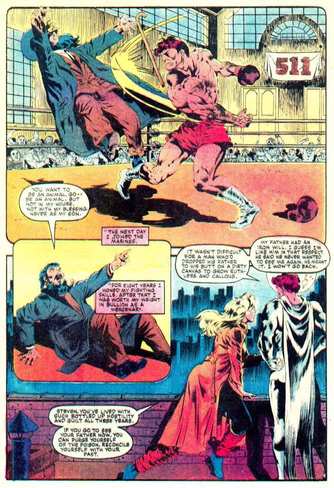 Marc’s frustration at his family’s persecution fueled his desire to defend himself and he spent his days training at the local gym. Eventually, Marc began to box for money and was skilled enough at 18 that he was seriously considering a career as a professional. Marc had hidden this violent life from his pacifist father but he could not deceive him forever. Elias confronted his son inside the ring, chastised him for the violence of the living he was making, and demanded that he give it up and return home. Marc responded by knocking his father across the ring with a powerful right hook and that was the last time the two men saw each other for 18 years. Since 1984 this has been all we’ve known about Marc Spector’s relationship with his father. Though many aspects of Moon Knight’s mythology have been revamped over the years, this storyline has been left untouched. While there is some sense of reconciliation between father and son at the close of issue 38, the legacy of this family dysfunction informs every incarnation of Marc Spector. Marc’s fierce loyalty to the Moon God Khonshu for example, may stem from the absence of a strong fatherly influence in his life. By resurrecting Marc and creating Moon Knight, Khonshu became his new father, at least in a spiritual sense. Also, by refocusing and encouraging the violence Spector’s father chastised him for, Khonshu gave Marc the acceptance that Elias wasn’t able to. But when we meet Elias Spector in 2016 it is long before Marc turns 18. Lemire shows Elias as a troubled parent struggling to understand his son’s shifting personalities. Unsure of what he can do to help he takes Marc to a psychiatrist and we learn that he must undergo special treatment away from home. You feel the compassion and concern in this father’s eyes as he realizes he can’t help his son by himself and instead of a pillar of piety we get to see Elias as a man just trying to be a good father. While there’s still potential for a boxing ring confrontation between father and son in the coming issues, Lemire adds both humanity and intimacy to Marc and Elias’ father/son relationship as they come to terms with Marc’s mental health. If we do see a Spector vs. Spector bout in the coming issues the stakes and the emotional weight of that event will be considerably greater than ever before. Returning to the story, as Marc listens to his father and psychiatrist’s muffled discussion from the hall Khonshu appears for the very first time. By bringing Khonshu in this early in Spector’s history, Lemire also extends the depth of the Moon God’s influence on Marc’s life. Khonshu calls young Marc his son and tells him that one day he will come to the Moon God and be complete, planting the seeds of dependence and manipulation that will plague Marc for decades. Back in the present, Marc reunites with Gena and they talk about Spector’s confused sense of reality and his mission to return to the hospital over pancakes. Spector then travels underground in search of Crawley and Anubis. Bargaining for his friend’s soul, Marc agrees to descend into the Othervoid to retrieve something Anubis lost there a long time ago. As Spector dives into the Othervoid returning artist Greg Smallwood really shines. Color, scale, and gravity twist and meld as the issue wraps up and Marc arrives in the Othervoid. I won’t spoil what he discovers there, but it blew my mind. I’m not sure I’ve ever had the experience of coming to the end of a comic book with as much excitement and curiosity about what came before as what is going to happen next! Until next time, Geek On! Written by Joel T. Lewis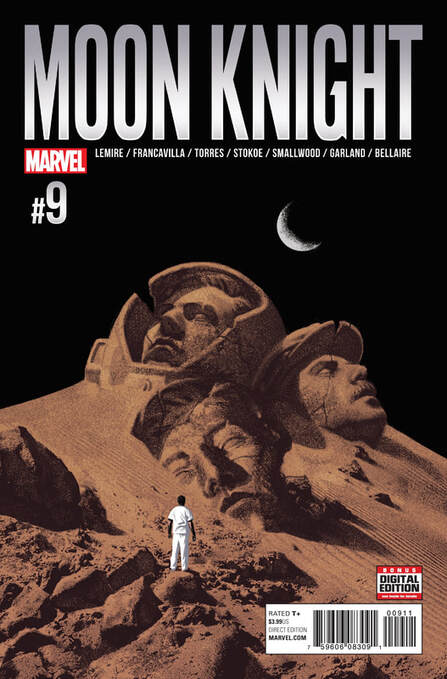 There is a tried and true way to determine whether or not I’ve been moved by something I've read. You'll see me finish a sentence, look away from the page, and put whatever I'm reading down for a minute. Everything I've ever read that's had an impact on me has made me do this. At the end of a line I'm so blown away that I have to let the moment sit in my mind. I have to breathe it in before I continue. I've sung the praises of Jeff Lemire’s Moon Knight for 8 articles straight and it’s because every single issue has made me do this. But then with the 9th issue, Lemire gave Moon Knight fans, gave me, something so breathtakingly beautiful that I have been nearly moved to tears with each re-reading. This is perhaps the comic book that means the most to me and here’s why. In the 200+ issues that bear his name and the countless appearances he’s made as an Avenger, Defender, Hero for Hire, and Marvel Knight, Moon Knight has never treated his psyche gently. He’s always been a splintered figure, as much in conflict with himself as with the Bushman or Black Spectre. Throughout his publication we’ve seen Marc Spector batter, abuse, suppress, and conceal his multiple identities in order to present himself as a sane man. In the beginning he used his fractured psyche to divide himself between the violence of the street, the comfort and intimacy of his home, and the twisted darkness of his past. Despite his best efforts, Moon Knight was never able to keep his personalities separate. This fact has always been met with conflict and censure. When the darkness of Marc Spector’s past creeps in and affects Marlene’s relationship with Steven Grant, Grant attempts to stamp out that persona, denying his past. When working with the West Coast Avengers, Moon Knight doesn’t reveal his confusion of personality with his teammates out of fear of expulsion. Even in the throes of Civil War, Iron Man decides against arresting Moon Knight for fear of worsening his mental health and Captain America refuses to recruit him because of his unpredictability. With each new chapter in the Moon Knight saga writers have reshuffled and highlighted each of his personalities but they have always been portrayed as blunt tools to accomplish certain goals or inconvenient barriers that negatively affect Moon Knight’s ability to connect to those closest to him. True to form, Jeff Lemire’s 9th issue pays a heartfelt tribute to the history of Moon Knight, while blazing a bold new trail with how he handles the character’s splintered psyche. Marc Spector tells Jake Lockley, Captain Spector, and Steven Grant that while they are all aspects of his mind, they don’t really exist. Understandably, they don’t take this news too well and interrogate Spector, probing for some hidden agenda. Marc explains that he has to deal with each of them in order to move forward. Grant asks how the sand-covered landscape of his Marvel Studios movie has come to life and Spector tells him there is no movie, calling him by his name. Grant asks, 'You know me?' Spector replies, 'Of course I do. I’ve known you the longest Steven.' He goes on to identify Jack Lockley as another of his old aliases. As Marc points to Captain Spector, acknowledging how new and bizarre this persona seems to him, we are treated to the last panels of James Stokoe. Captain Spector cries out for help as he dissolves into sand carried away by the wind. Next, we shift to the art style of Francesco Francavilla as Jake Lockley (Dressed as Moon Knight) attacks Marc, accusing him of murdering the Captain. 'What did you do to him?' Lockley shouts as he slugs Marc across the face. Marc responds with the not-so-sinister truth, 'Just confronting him did it. He was weak. Not fully formed, just a sketch, really.' Lockley reaches for the truncheon strapped to his leg, hell-bent on duking it out with Marc. Marc begs him to reconsider, 'I don’t want to fight you. Fighting you is what I’ve always done. And it led us here. I want to try a new way...a better way. I want to acknowledge you. Accept you. And then move on.' Lockley ignores this earnest request and presses the attack. Marc reluctantly fights back, accepting that since violence is all that Lockley understands, it is with violence that he must be dealt with. Pulling a crescent dart from inside his suit coat, Marc apologizes to Lockley, 'I’m sorry it had to go this way...Yes I’ll always need you...a part of you anyway.' Lockley falls and disappears in a cloud of sand. Marc turns to face Steven only to discover that he’s run away. Calling his name, Marc follows his footsteps in the sand down the abandoned streets of New Egypt and catches up with him in an empty office building. Grant has stopped running and can’t understand how he isn’t real. He remembers so much of his past: Coney Island, and seeing movies, and falling in love. How can that not be real? Marc kneels down to comfort Steven: 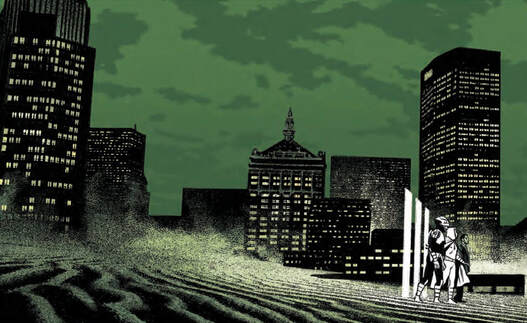 'Because it was real. You’ve always been with me. We shared our lives together. You were the first. You came to me when I was very young. At first I thought you were an imaginary friend that I would play with when I was alone at home. Then we weren’t playing together. I was you. Then I’d be me again for a while.' Marc confides in Steven about the horror of waking up in a mental hospital and having his deepest fear realized: he was losing himself to madness. Through these panels brought to life by Wilfredo Torres, Jeff Lemire gives Marc something no other comic writer has, self-acceptance. Marc tells Steven: 'I--I’ve been sick my whole life. And I’ve felt ashamed of that. I tried to hide it. I think that’s what the mask really was. Another way to hide. But I don’t want to hide anymore. I don’t want to be ashamed anymore. I just want to be me. I know I will never be cured. But I need to at least find a better way to live with this.' Marc asks Steven if he will help him. Help him restore his identity and find himself again. Steven agrees with one condition, 'Promise me you’ll find a way to be happy.' As the two men embrace Grant disappears and Marc is left alone. In almost deafening silence Marc Spector feels the most clear-headed he’s been in 9 straight issues. And he has a plan. 1. Go back to the hospital and 2. Kill Khonshu. Now I know this is an especially long recap but I just have to make a few more points before I put this issue away for a while. First I want to address Marc Spector’s description of the Captain Spector/Werewolves on the moon storyline as just a sketch. Marc Spector the Starfighter and his quest to defend the human refugees on the moon from an invasion of space werewolves is one of the most ambitious re-imaginings of Moon Knight ever. Jeff Lemire could have written a 10 issue series of that storyline by itself and I would’ve bought every issue. But he didn’t. He introduced that storyline and that persona to make a point about how integral Jake Lockley and Steven Grant have been to the history of Moon Knight and he allows that storyline and character design to fade away for the sake of the larger narrative. Ambition, innovation, and respect for the history of the character. I cannot say it enough, Jeff Lemire was born to write Moon Knight Comics. Next I want to talk about what Lemire does with Marc Spector and Steven Grant’s relationship. Never before in a Moon Knight comic has Steven Grant existed before Marc Spector’s death in Egypt. By extending their history back to Marc’s childhood, Lemire contributes a humanity and an innocence to Spector’s identity disorder. Marc’s splintered psyche is not the result of a near-death experience at the feet of a Moon God statue or an actual death and resurrection at the hands of an Othervoid god. He was born with his mental condition. He mistook a fragment of his mind for an imaginary friend and shared his whole life with him. Suddenly Marc’s mental health problems aren’t some cruel cosmic violation, some unnatural joke that he’s been plagued with because of a vengeful god. Spector is human and his is the kind of pain that people cope with in real life. This has huge implications for the history of these two identities and I’m looking forward to going back and rereading some of the formative issues of Moon Knight with this continuity in mind. Finally, I’d like to discuss Marc’s acceptance of his mental condition. I can’t quite explain how beautiful it is for a character to be as vulnerable, honest, and optimistic as Marc Spector is about his mental health. He acknowledges his fear and his shame. He accepts that his condition isn’t going away, but that doesn’t stop him from wanting to live a healthier life. Jeff Lemire has given Moon Knight and his readers an incredible gift with issue 9 and all I can say is thank you. Until next time, Geek On! Written by Joel T. Lewis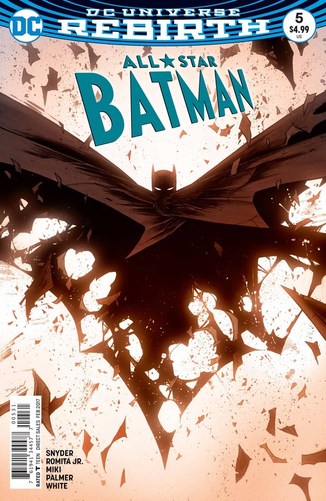 The dramatic conclusion of the Batman and Two-Face road trip from hell reveals some sinister details about the lengths Harvey Dent will go to accomplish his goals. Facing an angry mob of ordinary citizens who have come to stop Batman’s mission, Batman, Lark, Two-Face, and their captors are at a bit of a disadvantage. Not that that fact deters KGBeast from brandishing his automatic weapon hell bent on mass murder. Batman, in a desperate attempt to free himself, Lark, and Two-Face while also protecting the citizens on the shore, severs the mooring lines that keep the riverboat casino docked with a batarang. Depriving the Beast of his long-awaited messy massacre, Batman sends his former soviet foe into a rage while escaping his clutches aboard a giant floating poker chip. As Batman and company float downstream towards a waterfall, he triggers an explosion which sends the riverboat, with KGBeast, Penguin, Great White, and Black Mask careening into the shoreline, safe from a deadly plunge while Batman, Lark, and Two-Face are able to survive their tumble over the waterfall using Batman’s cape. The trio finally arrives at the Arkham family estate after a brief appearance from Tweedle-Dee and Tweedle-Dum who succumb to an impatient thrashing courtesy of Batman. Meanwhile, Alfred pleads with Gordon and Bullock to not descend the staircase hidden behind the clock in Bruce Wayne’s study. Gordon takes the butler aside and asks one final time for him to contact Batman and call him off. Alfred tells the commissioner that that is impossible and Gordon responds with stern resolve. Tonight the Batman must be exposed. Batman uncovers Harvey Dent’s hidden cure but before using it he runs one final test to insure it is indeed what Dent promised. It is not. Batman turns on Two-Face, who is in the process of transitioning over to the Dent personality and the three of them clash over their current predicament. Harvey developed a formula that would allow the personality within him that was strongest to triumph while chemically burning away the lesser identity, effectively committing suicide as Harvey Dent. Also, it was Harvey, not Two-Face who unleashed acid rain on Gotham in the first issue of All-Star Batman which kick started this whole storyline. Harvey, weary from the endless struggle with Two-Face didn’t develop a cure for his worse half, but a solution to his conflict. Batman calls this solution a surrender and is appalled. Dent makes one more startling revelation, pulling out a cell phone and calling Alfred. Finally, the reason behind Alfred’s betrayal in issue one is revealed! At the beginning of Batman’s career, in a rare moment of weakness, Alfred approached and hired someone to kill the Joker. Though he came to his senses and called off the hit within hours, the money he had wired to the assassin came from the same dummy fund that they had used to construct the Batcave. Dent was able to track that information and apply the leverage that led to Alfred shooting down the Batplane. Alfred begs and Dent demands that Batman administer the formula immediately or Gotham will be showered with the same formula, chemically dividing the citizens into camps of saints and monsters. Seemingly trapped by Dent’s scheme, Batman hammers him into the ground outside the Arkham Estate. Beating Two-Face and Dent out of disappointed frustration, Batman injects Dent. Surprised by the Dark Knight’s agreement, Dent calls off his biological strike and waits for the final transformation to begin. But something is wrong, the formula doesn’t seem to be working. 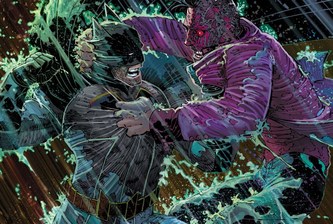 Batman, unbeknownst to Harvey Dent, anticipated an incomplete formula or some tampering by Two-Face getting in the way of curing his friend so he took certain precautions. While laid up in Harold Allnut’s workshop Batman and his old ally worked up a booster that, when taken with Dent’s formula, would burn away the Two-Face persona. Since he did not anticipate the sinister lengths that Dent had gone to in order to end his inner conflict, Batman deals out a just and fitting fate for his two-sided foe. Instead of Dent’s formula, Batman injected Two-Face with just the booster. Taken alone, this booster would prevent one personality from ever being burned away chemically as Dent had planned and would chemically shift how Harvey Dent and Two-Face would transition from now on. The conflict between Harvey Dent and Two-Face would now be a matter of will alone. If Harvey fights harder to gain control of their body on a certain day, he will win and if Two-Face fights harder he would gain control. Batman takes away Harvey’s ability to surrender to Two-Face and leaves them in a constant struggle of sheer willpower; a fitting reminder of how Harvey Dent’s force of will inspired Batman. Batman and Allnut also added a sedative to the booster which makes Harvey drop to the ground when he realizes his fate. Batman has little time to bathe in the glow of victory though because as he turns to Lark to help him take Dent back to Arkham, KGBeast appears once again. This time the ex-soviet assassin appears at the end of a spear driven through our hero’s back. Snyder jumps back and forth between Gordon’s SWAT strike team descending the hidden staircase at Wayne Manor and Batman and KGBeast’s brawl. Batman is saved from Beast’s promise of capture and torture by gunfire coming from the angry mob of citizens they left at the dock just a few pages before. This new attack enrages Beast but before he can open fire on the mob Batman tackles him, sending them both over the edge of the cliff behind the Arkham estate. The mob, grateful to their savior and horrified at what they had planned to do to him, peers over the cliff to discover Lark holding Batman’s cape. Snyder then cuts back to Wayne Manor to reveal that Gordon and Gotham’s finest have descended the hidden staircase only to find a mundane man-cave. Gordon seems relieved as he responds to one of his men, “What do you think, Edmunds? He has some mechanism that takes you down the wrong stairwell if you’re not the Batman. Something his own butler doesn’t know about?” Gordon smiles as he orders his men to leave the mansion. Narrowly escaping the rocky plunge Batman and Lark turn towards home and the once-angry mob parts to let them pass in peace. In the “My Own Worst Enemy” arc Scott Snyder delivered a fresh and fun Batman story with enough fan service and innovation to satisfy veteran fans and newcomers alike. All-Star Batman is accessible enough for you to jump right in and pays tribute to the history of Batman in a unique way which makes it a lot of fun to read. Developing an intimacy between the young Harvey Dent and troubled Bruce Wayne was a brilliant choice which enriched the history of those two characters and I’m excited to see what Scott Snyder does with the villain Batman faces next: Mr. Freeze! Until next time, Geek On! Written by John Edward Betancourt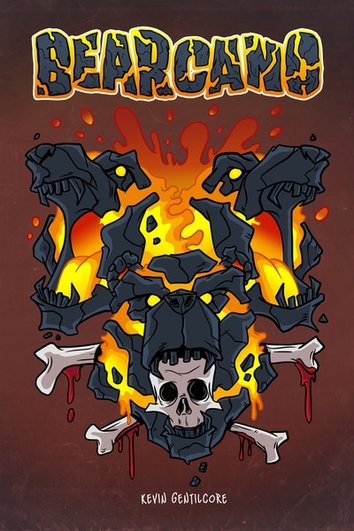 If there's one particular part of the comic book world that is starting to gain more and more of my attention, it's the indie comic book business. Because in a world filled with mainstream heroes, it's nice to know that there are still artists out there completely and utterly dedicated to non-mainstream stories and some of the stuff that's coming out of these smaller comic book companies, is absolutely amazing. Take for example Creephouse Comics. This Denver based company is one that we've highlighted before due to their awesome work in capturing the wonder of 1950's horror in their comic Teenage Love Zombies, and they recently decided to once again tackle a popular genre and provide everyone with their own take on the natural disaster/animal hybrid horror story that SyFy pioneered to popularity with their new comic book...BEARCANO. The plot for this particular book is largely immaterial, because well...the title says it all. You take a volcano and a bear and mash them together and you're treated to a violent and fiery monster that murders the ever living hell out of everything it encounters and let me just say it now, this book is completely and utterly magnificent. There's comedy to be found in just about every frame as the BEARCANO unleashes its fury on anything and everything and the no holds barred approach when it comes to this book results in moments that are so hilarious, I had to put the book down for a few moments to get the laughs out of my system...so I didn't ruin my brand new comic. But, what impressed me more is the sheer fact that this is also one intelligent comic book as well. Because the book offers far more within its pages than just carnage and gore, it's quite the satire of modern America as well. Our obsession with celebrities and social media and so much more are examined and lampooned in this book in similar comedic style, giving the story some incredible depth and setting it apart from any similar narratives in this magical sub genre meaning that when all is said and done, BEARCANO is the kind of comic book that truly has something to offer everyone and it's a book that you should get your hands on as soon as possible. Which brings us to the million dollar question, how do you get it? That's easy, head over to the BEARCANO page at Creephouse Comics' website and snag your copy today, and if you act quickly, you'll be able to get your hands on a special edition of the comic (limited to 50 issues) that includes a one-of-a-kind BEARCANO pin and sticker and is also autographed by writer Kevin Gentilcore. Either way, just make sure you get your hands on this book and treat yourself to a unique story that entertains and enriches the mind and oh yeah...features bears made of freakin' lava and a bigger body count than all four Sharknado movies combined... Written by Joel T. Lewis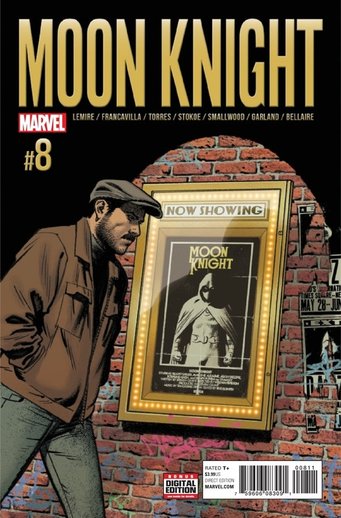 When we catch up with Jake Lockley at the beginning of issue 8 we find him in the custody of the New York Police Department being interrogated by two oddly familiar policemen. These are the same asylum orderlies that have hassled Moon Knight throughout this run. After peppering him with questions, these goons leave a confused Lockley to talk to Detective (formally Doctor) Emmet. Lockley is in a pretty tight spot as Emmet explains all that their investigation has revealed. The cab he drives is registered to a Jake Lockley, which must be an alias because his prints show him listed as Marc Spector in the police database. Plus, the shady costume they found in his cab isn’t going to help prove his innocence either. Emmet asks Spector about his history of serious mental health issues and asks if he remembers telling a story about werewolves on the moon as they brought him into custody. Frustrated and confused Spector demands for a second time to see his lawyer claiming he had nothing to do with the murder of Gena and her customers. As the page turns Spector shifts over to Steven Grant on the set of Moon Knight, a major motion picture. Grant yells, “Cut.” Grant appears to be directing an interrogation scene starring Jake Lockley and Detective Emmet. Confused, Grant agrees to let the actor playing Lockley try it again. As the camera rolls Grant shifts back into Spector in the interrogation room with Emmet, and Spector says, “Action.” Reeling, Spector learns that Emmet thinks he might be the serial killer that they’ve been calling Midnight Man in the press. Spector begs to be released so that he can go after the real Midnight Man but his pleas fall on deaf ears as Emmet calls in the orderlies/policemen to take him to the holding cells. Spector breaks free of the goons and manages to dodge the shot Emmet aims at him as he escapes. Changing into the mantle of Moon Knight he hits the streets in pursuit of Crawley, desperate for information on the Midnight Man. Crawley reminds Moon Knight that he’s sold his soul to Anubis and can’t help him because he’s not really there. Moon Knight cannot accept that and coerces a location out of Crawley and upon arriving there discovers Midnight Man holding Marlene hostage. As the two hooded and caped figures square off Midnight Man breaks character and complains about one of his lines. Spector is Grant again and he yells “Cut” as the actors portraying Moon Knight and Midnight Man on the set of the movie complain about the lines they’ve been given and the holes in the plot. They even reference how unlikely it would be that Crawley would know exactly where Midnight Man was going to be. Grant is unsettled by this and learns from one of his crew that some sound might have bled through from the adjacent sound stage. Marlene confirms this, telling Grant that it's “some space werewolf thing.” Grant suddenly remembers that he was bitten by General Lupinar on the moon as Captain Spector and as blood trickles down his shirt-collar he runs off the set towards what he thinks is the adjacent sound stage. Grant emerges onto the moon in the middle of the werewolf invasion and watches as General Lupinar stands over the bleeding body of Marc Spector. We actually get to see Grant, dressed as he was on the movie set, and Spector as two separate entities in the same panel. As Spector grapples with Lupinar on the moon, Steven Grant moves through the moon base, then Jake Lockley’s New York where Moon Knight is still grappling with Midnight Man, and back to the sound stage. Breaking away from their separate fights Lockley, Spector, and Grant all run for exits in their separate realities. Though their surroundings and pursuers are different, each man runs for the exit calling for the same person: Marlene. The final page of the issue is the triumphant return of artist Greg Smallwood and boy it was good to see him again. Captain Spector, Grant, and Lockley dressed as Moon Knight all emerge onto the sands of New Egypt from the first 5 issues of the series and are greeted by Marc Spector in his signature white suit. The panels curve into the shape of an exclamation point as Spector speaks, “Hey fellas, thanks for coming. We need to talk.” This topsy-turvy issue and its brilliant cliffhanger do a great job setting up the climax of the “Incarnations” run. As the three identities of Moon Knight bleed and bend into one another we accelerate towards a conclusion that will hopefully result in some grip on reality. Until next time, Geek On! Written by Joel T. Lewis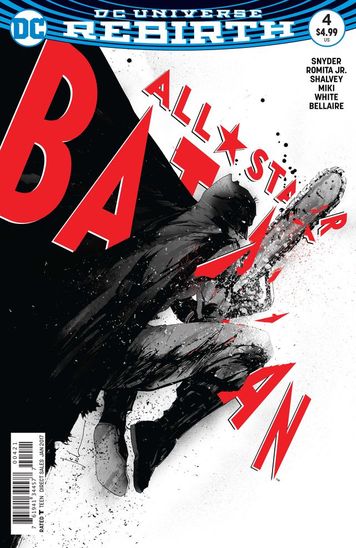 When last we saw the caped crusader he was at the mercy of Harvey Two-Face and a group of thugs affiliated with the Court of Owls called the Talons. Batman seemed to be defeated as Two-Face poured acid into his eyes. Luckily, we find out in the opening panels of issue 4 that Batman’s cowl has a built in shield that protects his flesh from the adverse effects of an acid bath. However, as Two-Face points out, it is the vapors of the acid that can do the real damage and Batman is rendered blind. This doesn't stop him from breaking free of the Court of Owls goons with the help of some nifty projectile panels built into the batsuit. Activating the echolocation component of his suit, Batman is able to trade blows with these thugs alongside his sidekick Lark. Two-Face breaks free and manages to flood the tunnel they've been fighting in and slips away up an access tunnel. Lark and Batman are trapped underwater by cables tied around their ankles courtesy of the Talons. With Lark’s visor leaking and Batman’s echolocation array shorting out Batman uses the only trick left up his sleeve: sound. Attacking the Talons’ sensitive eardrums underwater with Lark’s harsh rock music, Batman and Lark manage to escape and subdue Two-Face once again. Aboard a biplane, Batman confides in Lark the rest of his and young Harvey Dent’s childhood schemes as his eyesight slowly recovers. The troubled boys had made a pact: that they would kill the other boy’s tormentor. Harvey would kill Joe Chill and Bruce would kill Harvey’s father. But then Harvey's father sent him something at camp. When he would beat his son, Mr. Dent would flip his double tailed coin, saying if it came up heads he wouldn't touch his son. Harvey receives his father's coin in the mail but it has been recast as a double headed one. This symbolic gesture from his father meant he would never hurt his son again. Batman describes the shift in Harvey that day like this, “He wasn't seeing the world as it was, but how he would make it. It's not analysis. It's not acceptance. It's force of will.” 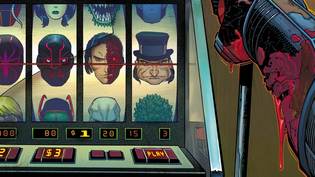 Though young Bruce knew that his friend would be beaten again by his father, the man he grew into admires the willful optimism that defined Harvey Dent from that day on. Scott Snyder adds another layer to the intimacy between Bruce Wayne and Harvey Dent with this final revelation. Harvey taught Bruce the power of the human will at a very young age. By refusing to see the world as the twisted cruel place that wrenched Bruce’s family from him and compels his own father to beat him, Harvey shook the hatred and conviction in his young friend. Through sheer force of will Harvey Dent would see the world as a better place. This is the fire that fueled his career as a public defender, and in a very real way it's the fire that inspired Bruce to don the cape and cowl. As Lark hands Batman Two-Face’s coin, another biplane smokes and veers off course in the background and a familiar pair of combat boots land between Batman and Lark. A black glove snatches the coin from Batman’s hand just before that boot hits the back of his head and the lights go out. KGBeast has returned and he's taken Batman, Lark, and Two-Face to an abandoned casino riverboat where Black Mask, Great White, and the Penguin meet them to discuss their fate. After trading insults and muffling Batman’s quips, the three mob bosses reveal that they've conspired with Harvey behind Batman and Two-Face’s back. As a safety net in case Batman wasn't able to get Two-Face where he planned to, Harvey planted a tracking device in himself so he could be found and killed before wreaking more havoc with his blackmail material. But one good twist deserves another: as Penguin moves into extract Two-Face’s blackmail codes from him the riverboat shakes from an explosion. Two-Face was aware of his tracking device and pushed the signal of it a little further to a group of people who have a vested interest in seeing the villain walk free. Still struggling to see as a result of the acid bath, Batman asks Lark who has come to save Two-Face and is shocked to see and hear the answer: they're just regular citizens and they're not here to negotiate. Can Batman and Lark defend themselves against ordinary citizens? Will Two-Face finally be rid of Harvey Dent, or will it be the other way around? Until next time, Geek On! |
Archives
May 2024
|
|
© 2012-2025, Nerds That Geek LLC.
All Rights Reserved. |
uWeb Hosting by FatCow
